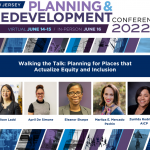New Jersey Future Blog
Broadband for All: The Geography of Digital Equity in New Jersey
September 16th, 2020 by Kimberley Irby
Today, the internet is the medium through which people access healthcare, housing, employment, safety, and education. Access to the internet is an essential public good, as much as access to clean water, energy and transportation. Recent Census Bureau estimates indicate that 16-17% of households (about half a million) in New Jersey lack internet access. For New Jersey’s recovery from the pandemic to be successful, everyone should have the ability to access the internet at reasonable speeds with affordable prices regardless of their geography or income.
Extent of the digital divide in New Jersey
Before the pandemic necessitated many to work or learn from home, the digital divide throughout the country was apparent in terms of geography, class, and race. In 2018, NJ Spotlight published an interactive map, featuring American Community Survey (ACS) 2013-2017 estimates, that revealed access issues in low-income urban and rural areas in New Jersey, similar to the rest of the nation. According to the data, people in fewer than 60 percent of households could go online in the cities of Perth Amboy, Salem, Bridgeton, Camden, and Trenton, whereas at least 95 percent of households had internet access in 17 wealthier communities in the north or central parts of the state. It is important to note that ACS data only provides estimates and current Federal Communications Commission (FCC) data conveys significant overestimates of internet coverage. To truly close the divide and achieve digital equity, it is important that we have the most up-to-date and accurate data possible.
What we can do about the digital divide in New Jersey
BroadbandNow claims that the two most effective ways state and local governments can improve their broadband situation are by: 1) creating better mapping and adopting smarter funding strategies and 2) promoting and encouraging community broadband solutions in low-competition areas. BroadbandNow further claims that both of these methods are at odds with the actions of dominant Internet Service Providers (ISPs) that have contributed to inflated measurements of internet speeds and competition at the federal level and fought against municipal broadband. Thus, it is critical to first understand where and what type of coverage is available in New Jersey. An effective way to do this is through a statewide broadband office, which can not only collect data, but also communicate, coordinate, plan, and fund. Although COVID-19 is resulting in slashed state budgets, we can still look to examples like New York, Minnesota, Illinois, and Georgia, for inspiration and guidance.
Community or municipal broadband refers to broadband internet access services that are provided either fully or partially by local governments. The benefit of municipal broadband, when done well, is that it provides high-speed internet with rates that are competitive with those of national ISPs. To date, no municipal networks exist in the state, but there is pending legislation (Assembly Bill A850) to create a “Community Broadband Study Commission” that would evaluate the feasibility of establishing community broadband networks. Public-private partnerships are another popular alternative for expanding access. In fact, some types of municipal broadband are achieved through these partnerships. In March 2020, another Assembly bill (A3649) was introduced that would require the Office of Information and Technology (OIT) to establish a statewide wireless network through a public-private partnership agreement, in which the private entity would assume responsibility for construction and cover some or all of the up-front costs.
The future of the digital divide in New Jersey
Currently, other organizations in the region are working to assess the situation in more depth and recommend specific policies to enact. For example, the Delaware Valley Regional Planning Commission is conducting a three-part study on broadband deployment and access throughout the Greater Philadelphia area. The first part, Discussing Technology, outlines broadband basics and deployment throughout the region. The upcoming second part, Understanding the Digital Divide, will cover the extent of the digital divide at the neighborhood level as well as its ramifications during the COVID-19 pandemic, and the third part, Bridging the Digital Divide, will feature policy recommendations.
From the data we currently have, despite the lack of precision, we know that New Jersey is one of the most highly wired states, if not the highest, in the nation. Thus, it’s within our reach to become the first state to actually achieve full broadband coverage. Given how critical internet access is to quality of life and equitable, inclusive communities, closing the digital divide should be a priority for New Jersey as it recovers from the economic damage of the pandemic. If our government commits to obtaining updated data and exploring solutions for the communities most in need, we can cement our status as a broadband leader and prove that digital equity is integral to New Jersey’s future.
See the full analysis here.
Related Posts
Tags: broadband, digital equity, equity, geography, internet, internet access, recovery
















